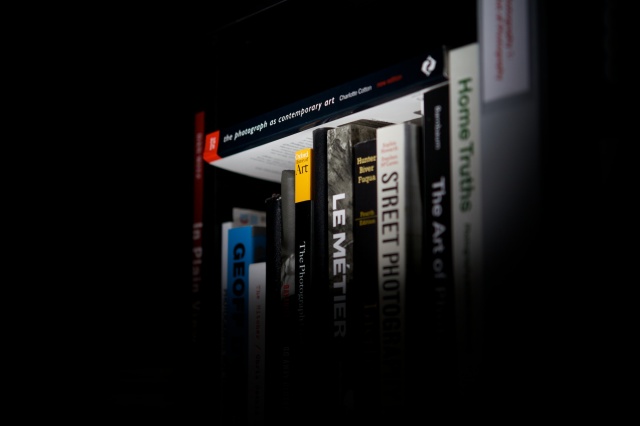The Photograph as Contemporary Art Charlotte Cotton Free Online
Normally, I'd write up a book after reading the whole affair, rather than but a first chapter, simply for this book, I've made an exception.
I've mentioned a couple of times on this weblog that I have a background and education in engineering. Studying and particularly expressing my opinions on art has been a challenge. So far, while I may accept aspired to artistic work, my photography has remained in the comfort and familiarity of documentary. I, like other students starting out on the grade whose blogs I've read, have occasionally struggled putting our finger on what art is and what makes one photograph fine art and another a happy snap.
On Sunday morning, information technology was raining for the seventh consecutive twenty-four hours and so rather than getting out and shooting pictures for my second consignment, I turned to the course reading list and began Charlotte Cotton's book. Three and a half hours later and I'd finished the outset affiliate! It'southward non that I'm a slow reader, information technology's just the sheer number of essential references and interesting leads that I concluded up following. The book is a revelation!

the photograph as contemporary fine art, charlotte cotton wool
It feels that the opening chapter of this book may exist the most important on the subject of photographic art that I take ever read. It explores the idea that a photograph tin be viewed simply as a documentary recording of the scene, or as a conceptualised subject. If the concept is not something we understand, tin engage in, are challenged by or indeed, interested in, the film becomes simply the object photographed. Additionally, when the image has been shot simply, to concentrate our attending on the discipline and concept, only we don't 'get' the concept, we're left with a photograph that makes no sense and doesn't hold our attention. Frequently, contemporary photography is not about 'virtuoso photographic technique' (in fact often the reverse, again to concentrate attention on the human activity being captured) merely at the same time nothing is left to chance. Artists volition command all elements of the creation of the work but leave the estimation up to the viewer. The result is a determined structure to the creation of the fine art followed by an unlimited range of responses to it.
Based on our pedagogy, our imagination and experiences, each of us volition have a dissimilar attitude and response to art. Using the examples offered by Cotton fiber, things like Jeanne Dunning's 'The Hulk 4' and Tatsumi Oramoto's Breadstuff Man creations are, in my view dangerously close to the line betwixt art and people interim daft! Although Cotton fiber tells united states that strapping bread to his face and beingness photographed with his mother who has Alzheimer's is 'a visual merging of her changed mental reality with his functioning of concrete difference', information technology leaves an uncomfortable feeling of exploitation.
Another accept that nosotros are introduced to is Erwin Wurm's. He photographs strangers, positioning them in cool poses, claiming that his fine art is the original idea, not the resulting photograph or his own performance.
This chapter also introduced me to the wonderful 'Retail' by Tim Davis. Fantastically crafted night time shots of urban America with corporate, neon signs reflected in the windows of houses. This piece of work comments on intrusion of advertising. As Cotton fiber points out, one of these images alone is interesting enough, but when presented as a serial or body of work they actually explore a concept – in this example, that commercialism is invasive and everywhere.
I'chiliad excited to get stuck in to the remainder of the book (particularly the chapter called DEADPAN. My favourite work and the style I'chiliad aiming for in my 2d assignment is very much this highly detailed but emotionless presentation) but will demand to be careful that it doesn't overwhelm me with references and research routes. This showtime chapter has addressed so many of my internal debates and I'd thoroughly recommend it to any beau students starting out as I am and struggling with the issue of what makes art. I'1000 sure this is why it's on the reading list.
When asked what her top photography tip was, Dayanita Singh said:
Read, read, read. Forget studying photography – but go and study literature. Then you volition bring something to the photography.
I'k not sure I completely agree with that, just I'll meet her halfway. Reading virtually photography always seems to be beneficial and rewarding for me and I must find fourth dimension to do it more often…
Reference:
Cotton fiber, C (2009)The photograph equally gimmicky art. London; Thames and Hudson
Malone, T. (10 Oct 2013)Dayanita Singh's best photo – a sulking schoolgirl. (Online). The Guardian. Available from http://www.theguardian.com/artanddesign/2013/oct/10/dayanita-singh-best-photograph-schoolgirl [27 January 2014]
campbellmosely1979.blogspot.com
Source: https://yeahyeahyeahyeahyeahblog.wordpress.com/2014/01/27/charlotte-cotton-the-photograph-as-contemporary-art-chapter-1/
0 Response to "The Photograph as Contemporary Art Charlotte Cotton Free Online"
Post a Comment